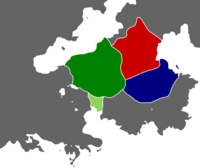Viragstag
This article is incomplete because it is pending further input from participants, or it is a work-in-progress by one author. Please comment on this article's talk page to share your input, comments and questions. Note: To contribute to this article, you may need to seek help from the author(s) of this page. |
Kingdom of Virag Viragstag | |||||||||
|---|---|---|---|---|---|---|---|---|---|
| 830–980 | |||||||||
|
Modern reconstitution of Viragstag royal banner | |||||||||
 The Lushyods dominated states in 850, with Viragstag in blue | |||||||||
| Capital | Viragzag | ||||||||
| Common languages | Lush | ||||||||
| Religion | Aletheism Alban Nazarism | ||||||||
| Government | Monarchy | ||||||||
| Sevr Korran | |||||||||
• 1022 - 1042 | Haldar I | ||||||||
• 957 - 980 (last) | Bezias III | ||||||||
| History | |||||||||
• Foundation of Viragzag | 830 | ||||||||
• Death in battle of Bezias III | 980 | ||||||||
| |||||||||
The Viragstag or Kingdom of the Lake was a medieval Lushyod state that existed in south-eastern Belisaria between the 9th and 10th centuries. It was founded in 829-830 when Havar I, a Lushyod prince from the Kingdom of the Drev led his retinue, his tribe, other adventurers, and their Ludic bondsmen on a southern migration to what is modern day Brumen. There, he founded the city of Viragzag on the northern shore of Lake Bluhen, then known by the Lushyods as Viragzod hence the name of both the city and the state. As monarch of the lake, Havar I built a strong state over Ludic, Southern Gothic, and Lushyod populations, and imposing its hegemony over what is northern Brumen.
Following the death of Havar, the kingdom entered a period of decline, locked in warfare with the southern kingdom of Waldreich and the other Gothic states while also struggling with internal conflicts between tribal lords. Back and forth of raids, counter-raids, sieges and localized battles would continue for the next 125 years until Viragzag was taken and its last king killed in battle ending Lushyod dominion over the region. The partition of Virastag among the victors and their partisans led to the creation of the modern constituent principalities of Brumen.
Background
Lake Bluhen before the Lushyods
The centuries following the departure of the Latin Empire but preceding the establishment of the Lushyodorstag is commonly known within Brumen as the War of the Three Nations. They saw long lasting low-intensity warfare between three competing powers - Sudentor, Waldreich, and Bewahren - each trying to establish their legitimacy as successor of Tervingia and hegemon of the southern Goths. Between these three forces many smaller kingdoms, generally representing only one or two tribes, were kept around as buffer states which loyalties changed depending on the balance of power, matrimonial policies, and internal struggles.
The region around Lake Bluhen was especially affected. Since the 3rd century it saw the implantation of many Ludic tribes which became locked in conflict with their Gothics predecessors. From the 6th century onward, after the dissolution of the Alban Federation under the diplomatic and military assaults of the Three States, lake Bluhen and the adjacent lands fell prey to myriads of petty warlords and tribal chieftains, none managing to maintain their power for more than one generation. As a result of this political anarchy it became derogatory known among the Three States' chroniclers as the Northern Emptiness.
